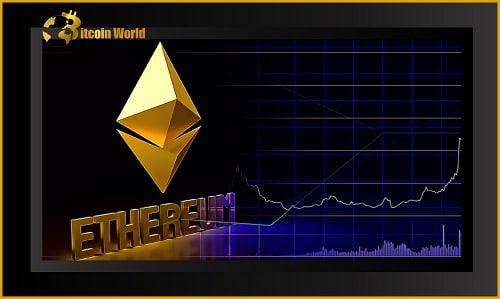Exciting news for Ethereum enthusiasts! Recent data from IntoTheBlock reveals a significant milestone in the Ethereum ecosystem. The number of crypto addresses holding a modest amount of Ether – between 0.1 and 1 ETH – has skyrocketed to a new all-time high. This isn’t just a random statistic; it’s a powerful signal pointing towards something big: Ethereum is becoming a truly widely adopted asset.
Think about it – we’re talking about everyday investors, the retail crowd, increasingly embracing Ethereum. Let’s dive into the numbers. Since the beginning of 2021, the count of these smaller Ethereum wallets has jumped by an impressive 98%! That’s a near doubling in just over a year. Collectively, these small wallets now hold a substantial 1.78 million ETH. This isn’t just pocket change; it’s a significant amount of Ether distributed across a vast number of users.
Why are so many people accumulating small amounts of Ethereum? Several factors are likely at play here. Firstly, Ethereum itself has experienced remarkable growth and maturity. Secondly, let’s not forget the impressive ETH price rally we saw, especially in 2021. ETH was a star performer in the crypto space, surging by around 400% to its peak in November. This price appreciation naturally attracts investors, including those new to the crypto world.
But it’s not just about price speculation. Ethereum has cemented its position as a powerhouse in the blockchain world, offering real-world utility across various sectors. Think about:
- Decentralized Finance (DeFi): Ethereum is the backbone of the DeFi revolution, enabling lending, borrowing, and trading without traditional intermediaries.
- Non-Fungible Tokens (NFTs): The NFT boom has largely been built on Ethereum, with digital art, collectibles, and virtual land all finding a home on the ETH blockchain.
- Staking: Ethereum allows users to stake their ETH and earn rewards, contributing to network security and earning passive income.
- Smart Contracts: Beyond DeFi and NFTs, Ethereum’s smart contract capabilities are being utilized in supply chain management, voting systems, and countless other innovative applications.
These diverse use cases make Ethereum more than just a cryptocurrency; it’s a versatile digital asset with tangible value and growing real-world applications. This utility, coupled with its investment potential, makes it an attractive option for retail investors looking to diversify their portfolios.
The Burning Question: What about Ethereum’s Burn Rate?
Interestingly, while Ethereum adoption grows, so does its token burn rate. Data from WatchTheBurn reveals that over 1.8 million ETH, valued at a staggering $5.6 billion, has been burned. This burning mechanism is a result of Ethereum’s transaction fee structure (EIP-1559), where a portion of transaction fees are destroyed, reducing the overall ETH supply. This burn rate is driven by the extensive use of the Ethereum network for various on-chain activities.
Despite this high burn rate, Ethereum remains a top earner among blockchains. This highlights the robust economic activity happening within the Ethereum ecosystem. The network is generating significant revenue even while reducing its token supply, potentially making ETH more valuable over time.
Activity vs. Holdings: A Tale of Two Metrics
While the number of small Ethereum wallets is booming, it’s worth noting that activity within this specific wallet segment remains relatively subdued. Why might this be? One likely culprit is periods of high “gas” fees on the Ethereum network. Gas fees are the transaction costs on Ethereum, and during times of network congestion, these fees can spike dramatically. We’ve seen instances where users were facing transaction costs as high as $50 in ETH! Such high fees can discourage smaller wallet holders from frequent on-chain activity, especially for smaller transactions.
Ethereum Price Check: Where Does ETH Stand Now?
As of the time of writing, Ethereum is trading around $3,086. To put this in perspective:
- It’s down about 36% from its all-time high.
- It’s up approximately 42% from its 2022 low point.
This price fluctuation is typical in the crypto market, but the underlying trend of increasing adoption, as evidenced by the growth in small wallets, paints a positive long-term picture for Ethereum.
In Conclusion: Ethereum’s Foundation is Strengthening
The surge in small Ethereum wallets is a compelling indicator of growing mainstream adoption. It suggests that more and more retail investors are recognizing the value proposition of Ethereum, not just as a speculative asset, but as a fundamental technology with diverse applications. While network activity in these smaller wallets may fluctuate due to gas fees, the increasing number of holders signals a strengthening foundation for the Ethereum ecosystem. As Ethereum 2.0 and scaling solutions continue to develop, addressing gas fee concerns, we can expect to see even greater engagement and adoption of this leading blockchain platform. The future looks bright for Ethereum and its expanding community of holders!
Related Posts – Ferrari joins the NFT universe through a collaboration with a Swiss…
Disclaimer: The information provided is not trading advice, Bitcoinworld.co.in holds no liability for any investments made based on the information provided on this page. We strongly recommend independent research and/or consultation with a qualified professional before making any investment decisions.


